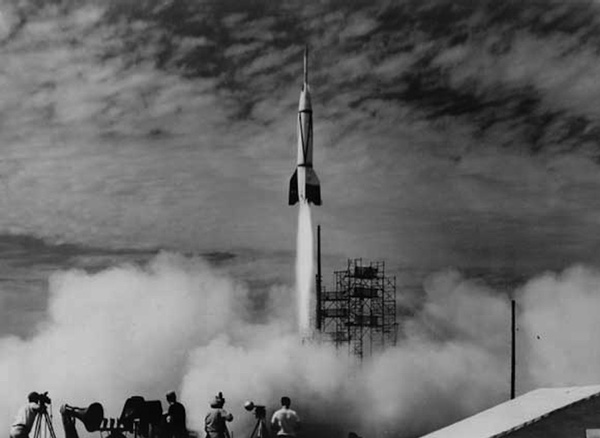An alternate, rocket-free history of spaceflightby John Hollaway
|
| I believe that, despite the universal adoption of its technology, the success of the V-2 as a launch vehicle was inimical to the development of space travel. |
Like all small boys I was an eager rubbernecker and I remember my disappointment when I found that I could not see the devastation because the bus route to my school that morning was blocked by debris. But the next day we ground up Lavender Hill past a wide area of destruction. Eight people had been killed and 68 seriously injured, but in a gesture of defiance a small tree had been decorated with the sort of Union Jacks that we waved on loyal or royal occasions.
Yet the V-2 rocket was not the war-winning device that Hitler had counted on. It killed about 9,000 people, almost all civilians, but did great economic damage to Germany. It cost the equivalent of about $20 billion—of the same order as the Apollo program—but in a far smaller economy and to no significant military advantage. What the V-2 did do was to lock space launch technology into a system that dominates the sector to this day.
In the 1930s, Robert Goddard in the US and Herman Oberth in Germany had already shown that oxygen and hydrocarbon fuels, used in conjunction with de Laval nozzles, gave exceptional thrust from a standing start. The V-2 demonstrated that stabilizing and guidance systems could transform this combination into extraordinary effective missiles. Come the atomic bomb it created the ultimate weapon, the ICBM. The Great Designer (Sergei Korolev) used it in the Soviet version to put up the Sputniks, then Yuri Gagarin and so on and so forth. In response, from America came Mercury, Gemini, and so on and so forth. To this day the only sure way to get things off the planet is to use liquid oxygen and a fuel and go straight up.
I must now give a health warning. My mental health, actually. Because I believe that, despite the universal adoption of its technology, the success of the V-2 as a launch vehicle was inimical to the development of space travel. To see why let us assume that World War II did not happen.
That is not quite as far-fetched as it might seem. In the British National Archives at Kew in the south of London are once-very-secret plans that envisaged the elimination of the German battle fleet by surprise and an invasion of Schleswig-Holstein. If they had been carried out and had been successful then the Kaiser—who was not necessarily the warlord he aspired to be—might have been brought to the negotiating table in early 1916. Poland could have been reconstituted as a buffer state between Russia and Germany, Alsace and Lorraine turned into independent duchies and so removed as friction points between France and Germany, the Russian revolution would not have occurred, and Germany would have continued its interrupted evolution into a social democracy. (I speak with a little authority; I hunted in the National Archives for this information and wrote an alternative history of World War I on this basis, The Iron Dice.)
| In our hypothetical peaceful planet, perhaps by 1950 we would be sending satellites up to broadcast wireless programs. By 1960 it may be that (black and white) television was also being transmitted. And so on and so forth. |
Then Goddard and Oberth might have gained some modest funding for their work and be driven to the conclusion that the enormous investments in technology needed to get man into space by blasting him up on a column of fire from a liquid oxygen and kerosene combination were not going to materialise during what Winston Churchill called the “sunlit uplands” of peacetime. A simpler approach would be needed. Perhaps the trick would be to fly him up through the stratosphere in something resembling an airplane and then have a more modest rocket to take him from there into low Earth orbit.
The ramjet had been patented in the 1920s and, in 1936, René LeDuc demonstrated that it would work—and if fast enough could presumably work in the thin air of the upper atmosphere. The trouble, of course, is that it needs to be rushing through the air at perhaps 160 kilometers per hour before it starts to give a useful thrust. But railroad trains in Europe were already achieving that on a regular basis. So, an all-metal airplane with big ramjets under its wings sitting on a railroad wagon might lift off and hurtle skywards.
And then what? Well, solid fuel rockets capable of carrying the aircraft to low Earth orbit were invented in the early 1940s. Arthur C. Clarke proposed the geostationary satellite in 1945. In our hypothetical peaceful planet, perhaps by 1950 we would be sending satellites up to broadcast wireless programs. By 1960 it may be that (black and white) television was also being transmitted. And so on and so forth.
The big problem would be that to send people up in these things would require some method of bringing them back. The challenge of reentry would loom large. Not having sent them up in a capsule, but in an airplane, would mean that they would have to come back in the aieplane. It would not be possible to use blunt body theory and ablate away the nose and leading edges. Or would it?
I’ll stop now, but you get the idea. A quieter, slower, less priapic space race.
